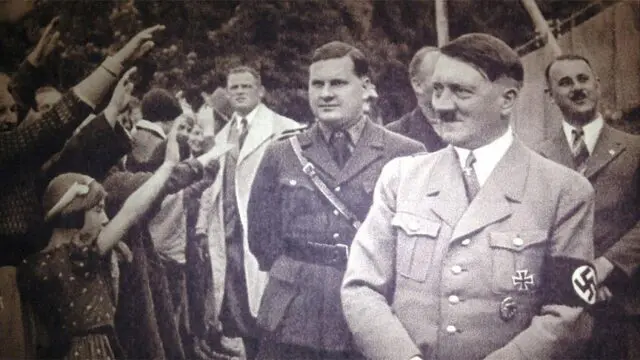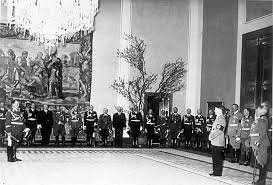The Nazi Party of Costa Rica was a Costa Rican National Socialist political organization founded in 1936 by the German community and other Costa Ricans of European origin (Spanish, Italian, etc.). Their meetings were held mainly at the German Club and on the farm of an Italian citizen.
It was chaired by the German engineer Max Effinger and included prominent citizens among its members, including the doctor Werner Rotter, from the San Juan de Dios Hospital. President León Cortés, a sympathizer of European fascism, appointed Effinger as an immigration adviser, which made it possible to restrict the entry of Polish Jews who had begun to enter the country. The Costa Rican National Socialists left behind an interesting and controversial legacy, as well as the famous monument of the “Golden Eagle”.
Although it is known as the “Nazi Party” the correct name would probably be the National Socialist Party of Costa Rica, however, modern historians traditionally designate it as the Nazi Party, similar to the American Nazi Party. Because there’s no way to be sure of the exact name.
Background
After the rise of Nazism in Germany in 1933, the slogan was clear: “From now on, a National Socialist Germany can only correspond to a National Socialist Germanness abroad,” said Ernst Wilhelm Bohle, leader of the Organization for Foreigners ( Auslandorganisation, AO) of the National Socialist German Workers’ Party (NSDAP).
The AO had the task of aligning the German communities around the world, under the banner of Nazism. The creation, in the Third Reich, of a totalitarian society, was accompanied by the extension towards politics, of a racial vision according to which the German blood should unite behind its nation and its Führer, Adolf Hitler.

Therefore, each German was subjected to the Gleichschaltung (equalization or Nazification). In Latin America, this leveling was more or less effective, but it led, in general, to deep divisions among the German communities.
Hints of the fascist ghost in Costa Rica
Costa Rica was not exempt from these conflicts. The frictions appeared with the creation of the local Nazi group, in 1932, and the extension of its ideology to the German institutions in the country, including the German School, founded in 1912. However, it seems that Nazification was achieved to a certain degree.
Several factors contributed to the good establishment of Nazism in the country. First, the national admiration for the German community was followed by a heroic image of Germanhood, which made them see, in Hitler and the Third Reich, its historical destiny.
Second, a good part of that community and those affiliated with the NSDAP were immigrants or descendants already socialized in the political atmosphere of the defeated Germany of 1918. The feelings of that time were decisive for the rise of Nazism in that country, and for the affiliation of their compatriots in other parts of the world.
Third, the authoritarian and caudillo concepts in national politics in the 1930s translated into pro-fascist sympathies. On the one hand, they opened the way for the propaganda demonstrations of adherents of fascism; on the other, they narrowed the room for maneuver against communist and anti-fascist militants, a fact that had its best expression in the anti-communism of the days of the Spanish Civil War (1936-1939).
Nazism spread through the set of traditional institutions of the German community. The Nazi group, despite having its own premises since 1934, organized its activities in the German Club. There, events related to the foreign policy of the Third Reich were held. The pro-Nazis spread photos and speeches of Hitler, and swore the Führer to “follow him wherever he went.”
In this propaganda diffusion, the official representatives of Nazi Germany seemed to play an important role. Entities such as the Ministry of Foreign Affairs, the Legation in Guatemala and the Consulate in San José, controlled the exhibition of “anti-German” films, and sent films, records, books and newspapers to institutions such as the German School and the Seminary School, mainly between 1936-1938, just at the beginning of the expansive wave of the Nazi regime in Europe.
Reasons for fear
At the close of the 1930s, fears about Hitler’s expansion into the country and Central America grew, especially among the communists, who denounced the “Creole totalitarianism” of the “aspirant to Führer” León Cortés (1936-1940) and “Nazicalderonism”.” by Rafael ÁngelCalderón Guardia (1940-1944) and his Catholic political environment. At the very least, much was true about pro-fascist sympathies and authoritarian tendencies within the ruling National Republican Party (PRN).
The important investments that the German community had in the country from previous decades began to be described as the first step towards ideological and military domination. The same was suspected of the presence of Germans in the public administration, especially when their interference in the immigration restrictions of Jews to the country was denounced, something that apparently involved the German Max Effinger.
In turn, the intense Nazi commercial policy was based on a system of exchange that forced coffee exporters to receive a currency (askimark) with which they could only purchase German products.
The resulting imbalance in transactions aroused strong criticism, even among coffee growers with an anti-communist background, such as Víctor Guardia, who since 1934 called the modality that Germany applied to its trade with Latin America and Eastern Europe “colonialist”.
American influence
The Third Reich had firm commercial interests in the region, but in the high command of the Nazi regime it was certain that Latin America was under the sphere of American influence, so the propaganda purposes were limited to the alleged cohesion of the Germanic community, and not to an imperial project.
With World War II the situation was reversed
However, the hemispheric alignment with the United States for World War II (1939-1945) was impeccable; the declaration of war on Germany at the end of 1941, and the issuance of “black lists” of German people and businesses, originated their persecution during the government of Calderón Guardia.

Persecution of Germans and Italians
One of the most contentious aspects of the Calderón administration would be its treatment of the country’s German and Italian minorities. The arrest of entire families of Italian, German, and a few Japanese immigrant or native-born citizens is reported. They were taken to a concentration camp located next to the then La Sabana International Airport where the National Stadium is currently located, and many others were deported to prisoner camps in the United States. The living conditions were deplorable. In addition, many of their properties were confiscated. Although they were released at the end of the war, the properties were not always returned.
In reality, the presence of Germans as public officials in Costa Rica was not a novelty, nor was it a Nazi artifice. Some had important positions in sectors such as health; This was the case of Dr. Werner Rotter, from the San Juan de Dios Hospital, whose openly Hitlerite views did not cause any major misgivings.
The PRN’s (Calderón’s) cruelty against the figure of Effinger (a former partner of León Cortés) to accuse the Germans of Nazi expansionism, was part of the growing atmosphere of persecution, and sought to fracture the courtesy electoral formula for 1944. By the way, it concealed links and sympathies that those close to Calderón Guardia, now rivals of Cortés, also maintained with European totalitarianisms.
Ghosts at home
Many fears surrounded the Nazi question, such as the possible emergence of a dictatorship in the country, the establishment of anti-Semitic policies, or the eradication of the opposition, specifically from the left.
These fears found support in an international context that was progressively seen as a confrontation between democracies and totalitarianisms; However, these misgivings had more to do with a local political culture prone to authoritarianism, caudillismo, xenophobia, and violence.
Such shadows covered the political and social order of the country during the 1930s and 1940s. For the civil and ecclesiastical authorities, protecting democracy, the family and property implied, for example, treating Jews and communists as contaminants of the nation, seen as as germs product of the economic crisis of the early 1930s. Anti-communism and the figure of the caudillo did not disappear with the social reforms of the 1940s, and anti-Semitism led Jews fleeing Nazism to be treated as an “undesirable race”.
Paradoxically, the Costa Rican authorities had to bring order to consuls like Ronaldo Falconer who, from Hamburg (Germany), dodged immigration restrictions to obtain visas for Jewish emigrants willing to settle in Costa Rica. At the Evian Conference (France, 1938), promoted by the United States in the face of the waves of Jewish migration in Europe, the position of Costa Rica (in the voice of the teacher and representative in France, Luis DoblesSegreda) was strict: prevent the arrival of “undesirable, dangerous elements” of “thugs whose entry is closed by very prudent laws.” The Nazi ghost could be driven away, but not the ghosts themselves.

